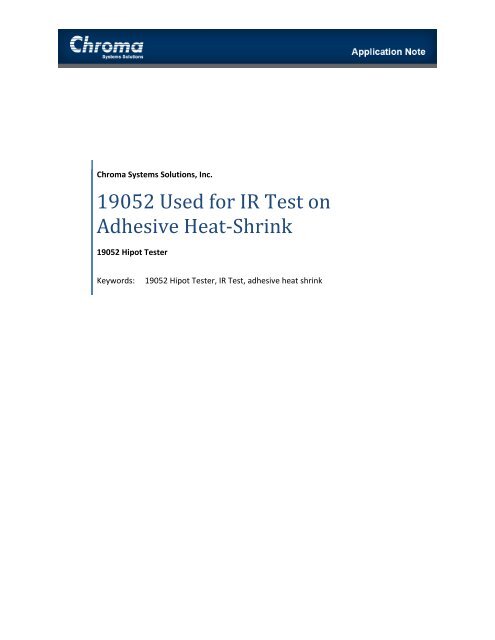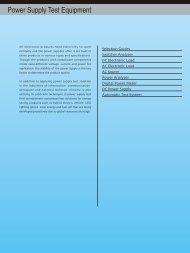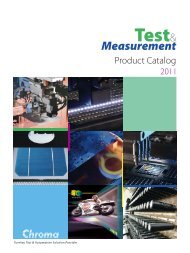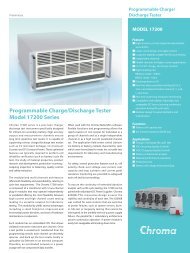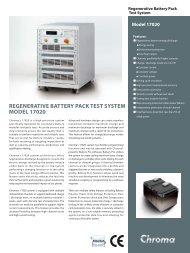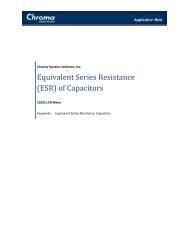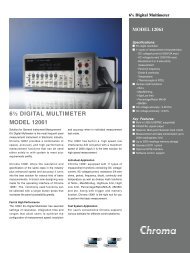19052 used for IR Test on Adhesive Heat-Shrink - Chroma Systems ...
19052 used for IR Test on Adhesive Heat-Shrink - Chroma Systems ...
19052 used for IR Test on Adhesive Heat-Shrink - Chroma Systems ...
Create successful ePaper yourself
Turn your PDF publications into a flip-book with our unique Google optimized e-Paper software.
<strong>Chroma</strong> <strong>Systems</strong> Soluti<strong>on</strong>s, Inc.<br />
<str<strong>on</strong>g>19052</str<strong>on</strong>g> Used <str<strong>on</strong>g>for</str<strong>on</strong>g> <str<strong>on</strong>g>IR</str<strong>on</strong>g> <str<strong>on</strong>g>Test</str<strong>on</strong>g> <strong>on</strong><br />
<strong>Adhesive</strong> <strong>Heat</strong>-<strong>Shrink</strong><br />
<str<strong>on</strong>g>19052</str<strong>on</strong>g> Hipot <str<strong>on</strong>g>Test</str<strong>on</strong>g>er<br />
Keywords:<br />
<str<strong>on</strong>g>19052</str<strong>on</strong>g> Hipot <str<strong>on</strong>g>Test</str<strong>on</strong>g>er, <str<strong>on</strong>g>IR</str<strong>on</strong>g> <str<strong>on</strong>g>Test</str<strong>on</strong>g>, adhesive heat shrink
Applicati<strong>on</strong> Note<br />
Title:<br />
Product Family:<br />
<str<strong>on</strong>g>19052</str<strong>on</strong>g> Used <str<strong>on</strong>g>for</str<strong>on</strong>g> <str<strong>on</strong>g>IR</str<strong>on</strong>g> <str<strong>on</strong>g>Test</str<strong>on</strong>g> <strong>on</strong><br />
<strong>Adhesive</strong> <strong>Heat</strong>-<strong>Shrink</strong><br />
19050 Series Hipot <str<strong>on</strong>g>Test</str<strong>on</strong>g>er AC/DC/<str<strong>on</strong>g>IR</str<strong>on</strong>g>/SCAN<br />
Many companies that splice wire and cable need to verify the integrity of the spliced areas of wiring.<br />
<strong>Adhesive</strong> heat shrink is <str<strong>on</strong>g>used</str<strong>on</strong>g> <str<strong>on</strong>g>for</str<strong>on</strong>g> insulating the spliced secti<strong>on</strong>s of wire. <strong>Adhesive</strong> heat shrink is an<br />
elastomeric compound applied to the outer surface of the cable, heated and shrunk to tightly fit the<br />
joint or splice. The compound’s rubber-like properties enable the joint to follow the thermally induced<br />
dimensi<strong>on</strong>al changes/c<strong>on</strong>tours of the cable insulati<strong>on</strong>. <strong>Adhesive</strong> heat-shrink is not a cable jacket,<br />
sheath or armor; it is a post-producti<strong>on</strong> fix <str<strong>on</strong>g>for</str<strong>on</strong>g> insulating a wire splice or tear.<br />
First, let’s look at the physical properties of a cable and define some basic terminology of the cable and<br />
wire industry. Figure 1.0 illustrates a simple coaxial cable. There are myriads of cable types and<br />
applicati<strong>on</strong>s but <str<strong>on</strong>g>for</str<strong>on</strong>g> this example we will stick with coaxial cable. A cable is made up a c<strong>on</strong>ductor at its<br />
core, a dielectric material <str<strong>on</strong>g>for</str<strong>on</strong>g> insulati<strong>on</strong> over the center c<strong>on</strong>ductor, a shield of semi-c<strong>on</strong>ductive material<br />
<str<strong>on</strong>g>for</str<strong>on</strong>g> ‘smoothing’ surface irregularities of the c<strong>on</strong>ductor and a jacket as the outer most layer to provide<br />
mechanical, thermal, chemical and envir<strong>on</strong>mental protecti<strong>on</strong>.<br />
© <strong>Chroma</strong> <strong>Systems</strong> Soluti<strong>on</strong>s, Inc. Page 2 of 4
Coaxial<br />
Cable<br />
Jacket<br />
Braided<br />
Shield<br />
Dielectric<br />
Core<br />
C<strong>on</strong>ductor<br />
Applicati<strong>on</strong> Note<br />
Quad<br />
Shield<br />
Coaxial<br />
Cable<br />
Jacket<br />
2nd<br />
Braided<br />
Shield<br />
2nd<br />
Aluminum<br />
Tape<br />
Shield<br />
1st<br />
Braided<br />
Shield<br />
1st<br />
Aluminum<br />
Tape<br />
Shield<br />
Dielectric<br />
Core<br />
C<strong>on</strong>ductor<br />
Figure 1: Coaxial Cable<br />
The c<strong>on</strong>ductor can be aluminum, copper or cooper covered steel and it can be solid or stranded. A<br />
stranded c<strong>on</strong>ductor is flexible but has a larger diameter than a solid <strong>on</strong>e. The dielectric material <str<strong>on</strong>g>used</str<strong>on</strong>g> to<br />
electrically insulate the c<strong>on</strong>ductor is a thermoplastic material (polyvinyl chloride, PVC) or a thermoset<br />
material (polyethylene, PE, crosslinked polyethylene, XLPE, or a synthetic rubber compound). The<br />
shields c<strong>on</strong>trol the electrical field in the cable. The c<strong>on</strong>ductor shield (semi-c<strong>on</strong>ductor material) makes<br />
the voltage <strong>on</strong> the inside of the c<strong>on</strong>ductor the same as the outside and the insulati<strong>on</strong> shield regulates<br />
the voltage <strong>on</strong> the outside of the insulati<strong>on</strong>. The jacket (plastic or PVC) covers and protects the inner<br />
layers. So what happens to this electrical system when the cable is spliced?<br />
<strong>Heat</strong> <strong>Shrink</strong> <str<strong>on</strong>g>IR</str<strong>on</strong>g> <str<strong>on</strong>g>Test</str<strong>on</strong>g><br />
When a cable is spliced the layers of electrical insulati<strong>on</strong> and c<strong>on</strong>ductivity may be <strong>on</strong>ly slightly altered (a<br />
tear) or entirely shorted (cut through). Cable is manufactured in great lengths, stored <strong>on</strong> reels,<br />
purchased and cut to fit <strong>on</strong> the job. Cables are spliced <str<strong>on</strong>g>for</str<strong>on</strong>g> many reas<strong>on</strong>s including terminati<strong>on</strong> from<br />
outdoor to indoor applicati<strong>on</strong>s. The outdoor cable per<str<strong>on</strong>g>for</str<strong>on</strong>g>ms in potentially harsh c<strong>on</strong>diti<strong>on</strong>s and the<br />
indoor cable must c<strong>on</strong><str<strong>on</strong>g>for</str<strong>on</strong>g>m to strict flammability (and other) requirements. So adhesive heat shrink is<br />
necessary and valuable tool in applicati<strong>on</strong>s where cable and wire are cut and spliced together. The<br />
splice test helps determine the integrity of the cable’s electrical insulati<strong>on</strong> and verifies its per<str<strong>on</strong>g>for</str<strong>on</strong>g>mance<br />
under adverse c<strong>on</strong>diti<strong>on</strong>s.<br />
Back to the heat shrink insulati<strong>on</strong> resistance test. First the wire is spliced, then the heat shrink is<br />
applied, and lastly, the insulati<strong>on</strong> tubing around the splicing is checked <str<strong>on</strong>g>for</str<strong>on</strong>g> integrity. The spliced and<br />
insulated wire is placed in a 5% saltwater soluti<strong>on</strong> bath <str<strong>on</strong>g>for</str<strong>on</strong>g> 24 hours. Next an <str<strong>on</strong>g>IR</str<strong>on</strong>g> tester is <str<strong>on</strong>g>used</str<strong>on</strong>g> to<br />
measure between the water in the bath and the c<strong>on</strong>ductor in the wire. IEC 61242, “Cable Reels <str<strong>on</strong>g>for</str<strong>on</strong>g><br />
Household and Similar Purposes”, specifies an insulati<strong>on</strong> resistance value to be 5MW at 500V DC. This is<br />
© <strong>Chroma</strong> <strong>Systems</strong> Soluti<strong>on</strong>s, Inc. Page 3 of 4
Applicati<strong>on</strong> Note<br />
just <strong>on</strong>e specificati<strong>on</strong> <str<strong>on</strong>g>for</str<strong>on</strong>g> cable reel tests. There is no single governing test standard <str<strong>on</strong>g>for</str<strong>on</strong>g> the cable and<br />
wire industry. Figure 2 illustrates the <str<strong>on</strong>g>IR</str<strong>on</strong>g> test setup using the <str<strong>on</strong>g>19052</str<strong>on</strong>g> Series Hipot <str<strong>on</strong>g>Test</str<strong>on</strong>g>er AC/DC/<str<strong>on</strong>g>IR</str<strong>on</strong>g>/SCAN.<br />
Figure 2: <strong>Adhesive</strong> <strong>Shrink</strong> <str<strong>on</strong>g>IR</str<strong>on</strong>g> <str<strong>on</strong>g>Test</str<strong>on</strong>g><br />
For complete product specificati<strong>on</strong>s <strong>on</strong> the <str<strong>on</strong>g>19052</str<strong>on</strong>g> Series Hipot <str<strong>on</strong>g>Test</str<strong>on</strong>g>er AC/DC/<str<strong>on</strong>g>IR</str<strong>on</strong>g>/SCAN or any of<br />
<strong>Chroma</strong>’s products, visit us at www.<strong>Chroma</strong>USA.com. Do you have an applicati<strong>on</strong> specific test? Call us<br />
at (949) 297-4848.<br />
© <strong>Chroma</strong> <strong>Systems</strong> Soluti<strong>on</strong>s, Inc. Page 4 of 4


